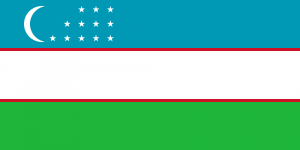Difference between revisions of "Language/Northern-uzbek/Grammar/Adjectives-formed-with-suffix-–-li"
< Language | Northern-uzbek | Grammar
Jump to navigation
Jump to search
m (Quick edit) |
m (Quick edit) |
||
| Line 1: | Line 1: | ||
[[File:Uzbek-Language-PolyglotClub.png|thumb]] | [[File:Uzbek-Language-PolyglotClub.png|thumb]] | ||
<div | <div class="pg_page_title"> Adjectives with that are formed with suffix – li. </div> | ||
In Uzbek in order to form a descriptive adjective one can add suffix “-li” to the noun. | In Uzbek in order to form a descriptive adjective one can add suffix “-li” to the noun. | ||
| Line 10: | Line 9: | ||
Often, verbs like yog’moq and esmoq are used with nouns to describe the weather patterns. For example: | Often, verbs like yog’moq and esmoq are used with nouns to describe the weather patterns. For example: | ||
*yomg’ir – rain, yog’moq – to fall | *yomg’ir – rain, yog’moq – to fall | ||
| Line 20: | Line 18: | ||
For example: | For example: | ||
*O’zbekistonda odatda qachon qor yog’adi (snows)? – Dekabrda Qaysi oylarda yomg’ir ko’p yog’adi? – Martda va aprelda. | *O’zbekistonda odatda qachon qor yog’adi (snows)? – Dekabrda Qaysi oylarda yomg’ir ko’p yog’adi? – Martda va aprelda. | ||
The verb bo’lmoq is used to describe weather patterns that are habitual, usual. For example: O’zbekistonda qish sovuq bo’ladi, yomg’ir bilan qor yog’adi. – Winter season in Uzbekistan is cold, rainy and snowy. | The verb bo’lmoq is used to describe weather patterns that are habitual, usual. For example: O’zbekistonda qish sovuq bo’ladi, yomg’ir bilan qor yog’adi. – Winter season in Uzbekistan is cold, rainy and snowy. | ||
<span link>Finish this lesson and explore these related pages:</span> [[Language/Northern-uzbek/Grammar/Pronouns|Pronouns]], [[Language/Northern-uzbek/Grammar/Future-Tense|Future Tense]], [[Language/Northern-uzbek/Grammar/How-to-Use-Have|How to Use Have]] & [[Language/Northern-uzbek/Grammar/Plural|Plural]]. | |||
==Source== | ==Source== | ||
https://slaviccenters.duke.edu/sites/slaviccenters.duke.edu/files/file-attachments/uzbek.original.pdf | https://slaviccenters.duke.edu/sites/slaviccenters.duke.edu/files/file-attachments/uzbek.original.pdf | ||
== | ==Other Lessons== | ||
* [[Language/Northern-uzbek/Grammar/Past-Perfect-Tense|Past Perfect Tense]] | * [[Language/Northern-uzbek/Grammar/Past-Perfect-Tense|Past Perfect Tense]] | ||
* [[Language/Northern-uzbek/Grammar/Future-Tense|Future Tense]] | * [[Language/Northern-uzbek/Grammar/Future-Tense|Future Tense]] | ||
| Line 38: | Line 35: | ||
* [[Language/Northern-uzbek/Grammar/Nouns|Nouns]] | * [[Language/Northern-uzbek/Grammar/Nouns|Nouns]] | ||
* [[Language/Northern-uzbek/Grammar/Postpositions|Postpositions]] | * [[Language/Northern-uzbek/Grammar/Postpositions|Postpositions]] | ||
<span links></span> | |||
Latest revision as of 13:06, 27 March 2023
Adjectives with that are formed with suffix – li.
In Uzbek in order to form a descriptive adjective one can add suffix “-li” to the noun.
For example:
- yomg’ir (rain)
- yomg’irli (rainy).
Often, verbs like yog’moq and esmoq are used with nouns to describe the weather patterns. For example:
- yomg’ir – rain, yog’moq – to fall
- yomg’ir yog’yapti – it’s raining
or
- shamol – wind, esmoq – to blow
- shamol esadi – it’s windy
For example:
- O’zbekistonda odatda qachon qor yog’adi (snows)? – Dekabrda Qaysi oylarda yomg’ir ko’p yog’adi? – Martda va aprelda.
The verb bo’lmoq is used to describe weather patterns that are habitual, usual. For example: O’zbekistonda qish sovuq bo’ladi, yomg’ir bilan qor yog’adi. – Winter season in Uzbekistan is cold, rainy and snowy.
Finish this lesson and explore these related pages: Pronouns, Future Tense, How to Use Have & Plural.
Source[edit | edit source]
Other Lessons[edit | edit source]
- Past Perfect Tense
- Future Tense
- Adjectives
- Present Continuous Tense
- Accusative case
- Conditional Mood
- Past Tense
- Nouns
- Postpositions
